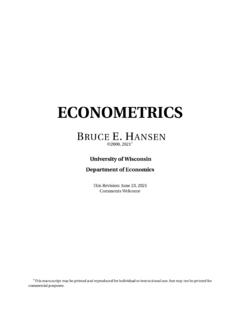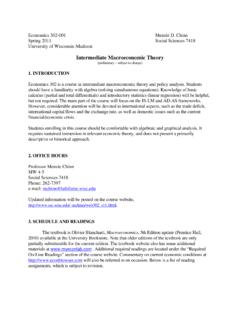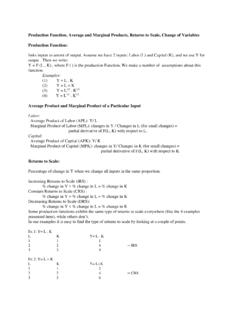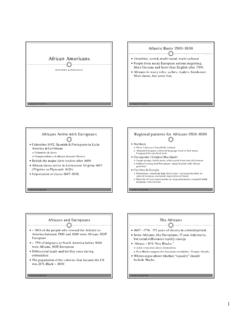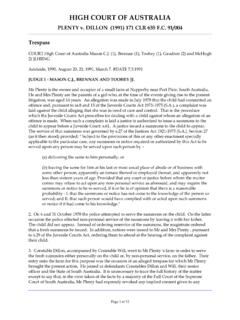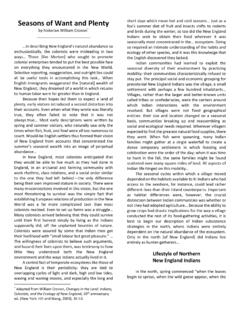Transcription of POWER AND PLENTY - University of Wisconsin–Madison
1 '-. ~-\ THE PRINCETON ECONOMIC HISTORY OF THE WESTERN WORLD JoelMokyr,Edlitor Growth in a Traditional Society: The French Countryside, 1450-1815, by Philip T. Hoffman The Vanishing Irish: Households, Migration, and the Rural Economy in Ireland, 1850-1914, byTimothyW. Guinnane Black '47 and Beyond: The Great Irish Famine in History, Economy, and Memory, by Cormac 6 Grada The Great Divergence: China, Europe, and the Making of the Modem World Economy, by Kenneth Pomeranz The Big Problem of Small Change, by Thomas J. Sargent and Franvois R. Velde Farm to Factory: A Reinterpretation of the Soviet Industrial Revolution, by Robert C. Allen Quarter Notes and Bank Notes: The Economics of Music Composition in the Eighteenth and Nineteenth Centuries, byE M.
2 Scherer The Strictures of Inheritance: The Dutch Economy in the Nineteenth Century, by Jan Lui ten van Zan den and Arthur van Riel Understanding the Process of Economic Change, by Douglass C. North Feeding the World: An Economic History of World Agriculture, 1800-2000, by Giovanni Federico Cultures Merging: A Historical and Economic Critique of Culture, by Eric L. Jones The European Economy since 1945: Coordinated Capitalism and Beyond, by Barry Eichengreen War, Wine, and Taxes: The Political Economy of Anglo-French Trade, 1689-1900, by John V. C. Nye A Farewell to Alms: A Brief Economic History of the World, by Gregory Clark POWER and PLENTY : Trade, War, and the World Economy in the Second Millennium, by Ronald Findlay and Kevin H.
3 O'Rourke POWER over Peoples: Technology, Environments, and Western Imperialism, 1400 to the Present, by Daniel R. Headrick ~ l POWER AND PLENTY TRADE, WAR, AND THE WORLD ECONOMY IN THE SECOND MILLENNIUM RONALD FINDLAY KEVIN H. O'ROURKE PRINCETON University PRESS PRINCETON AND OXFORD CHAPTER 6 and Engerman 2000). Furthermore, terms seems to us to be profoundly ; was required to make the techno-[, but the key question for us is what se breakthroughs in the absence of 1 this in turn have implied for future urt of the eighteenth century was n economic history. Even though ave ourselves noted in this volume ~ economic expansion. Examples in the last centuries of the first e in China under the Sung dynasty ies, the general prosperity of the Mongolica, the rapid recovery in after the Black Death, the export-rce in Southeast Asia from 1400 to eventeenth century, and the great ury China, to name only some of 'world history, in the terminology :hese episodes however, with the )Om in the seventeenth century, er capita income.]
4 T really marks out the Industrial mces was the fact that this burst vas sustained for the duration of Previous efflorescences, whether commercialization, all inevitably number of reasons (although in Asian efflorescences, one could n by Mongols or Dutchmen as an seen how a Malthusian society ;hnological innovation must in ints of limited land and natural ,f its possible expansion. Alter-icing "Smithian growth," which conomic activity accompanying he division of labor, caused by a val of artificial barriers, possibly novations in agriculture, manu-:! relevant connections between 1rther gains from specialization ill inevitably end (Kelly 1997). TRADE AND THE INDUSTRIAL REVOLUTION 339 We argue that international trade was a key reason why the British _ Industrial Revolution was different.)
5 The argument comes in two parts. First, a given domestic stimulus to growth, such as the new tech-; _ J _,_, nologies of the Industrial Revolution, led to a greater rise in incomes ~ as a result of the opportunities afforded by international trade. By I."\ ..Y helping the economy escape from resource constraints, trade ensured ~ rJ2 that technological change translated into a more sustained growth experience than would otherwise have been possible. Second, the (:;'\ extent of technological change itself depended at least to some extent ~ on the openness of the economy to trade. Both arguments rely crucially on the well-known fact that trade systematically raises the elasticities of supply and demand facing an econom_1"Nevertheless, it is useful to consider each in turn.)
6 Our first claim is that the remarkable innovations of the Industrial Q Revolution would not have had the deep and sustained consequences that they did if British industry had not operated within the global framework of sources of raw materials and markets for finished products that had been developed during the heyday of mercantilism and the Navigation Acts, and consolidated by the victories in the long series of wars against the Dutch and French. Slavery and the plantation economy of the New World, supplying first sugar and then cotton, the two major British imports for ~_nvo hundred ye<~fS, was an integral_part gf this Atlantic Systemf "New" economic nfstoriaris - -priclelliemselves on the use of counterfiictual thought experiments to examine historical questions, such as the economic sigrlificance of the introduction of the railroad.
7 It is therefore somewhat surprising that virtually no one has attempted a counterfactual study of what would have happened to the Lancashire cotton textile industry if there had not been any British colonies or slavery in the New World. Would India and Egypt, or free white labor in the Americas, have been able to fill the gap? Would some other industry, or country, have quickly emerged to take the place of cotton manufacturing in England? What would have happened to Lancashire had overseas markets not been available to -it, or if it had had to source all its raw materials supplies at home? And what in turn would this have implied for the British economy as awhole? ~ In order to consider such question~ a general equilibrium model of the Atlantic economy as a whore is needed, such as the one provided by Findlay (1990), inspired by the pioneering contribution of Darity (1982).
8 The model has three regions. Britain (or Europe) produces manufactures with capital and labor, which is assumed to be in fixed supply, and a primary intermediate input such as raw / 6'C ~v ~ ~ 340 CHAPTER 6 cotton that is worked up into fabric, or raw sugar that is refined for final consumption. America (or the New World) produces the raw material that is exported and used as the intermediate input into manufacturing in Britain, in exchange for manufactures. It produces this raw material with slave labor imported from Africa at a rising marginal cost, and land that is in fixed supply. Africa exports slaves in exchange for imports of manufactures. Each region's trade is balanced overall, on a multilateral basis.
9 Capital is in perfectly elastic supply at a constant rate of interest, equal to the rate of time preference in Britain and America. The slave population in America has a death rate higher than its birth rate, so an annual flow of imports is needed from Africa to keep the slave population constant. What is the impact of the Industrial Revolution in the context of this model? Following our previous discussion, the Industrial Revolution is modeled as a positive technological shock, increasing the efficiency with which capital and labor in Britain convert the imported raw material into final manufactured output. The consequent increase in British industrial output raises the demand for the American raw material, and hence the price of the raw material increases, improving the terms of trade of America.
10 The output of the raw material and the steady-state slave population in America go up, as do the price and export of slaves from Africa (since increased raw material output raises the demand for slave labor). An increase in the labor force in Britain would have a similar expansionary effect on all the endogenous variables of the Atlantic System, by boosting British industrial output. An increase in the supply of land in America would also have an expansionary effect on the whole system, but would reduce the price of the raw material by increasing its supply and turn the terms of trade against America and in favor of Britain. Any expansion in Britain or America raises the price and supply of slaves from Africa, and so turns the terms of trade in favor of slave-exporting African states such as Dahomey and Benin.



